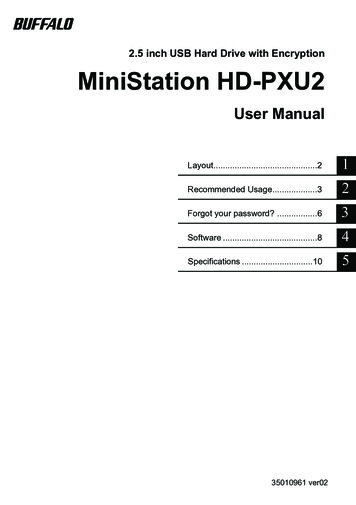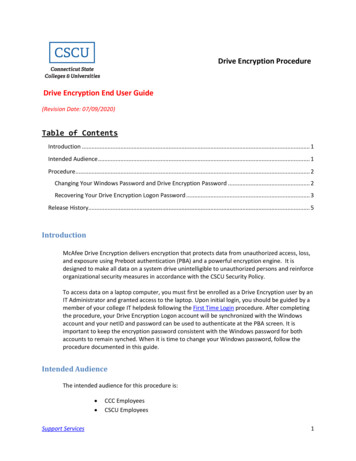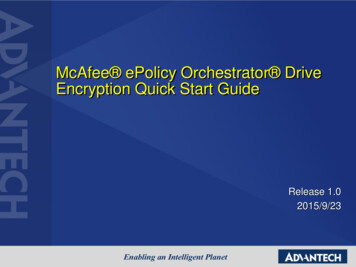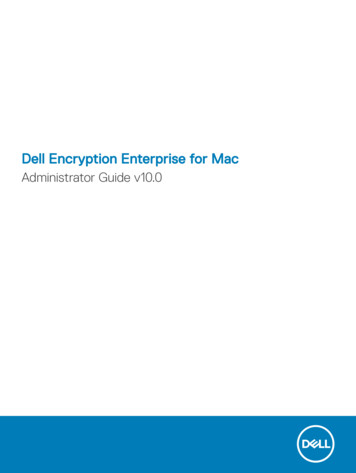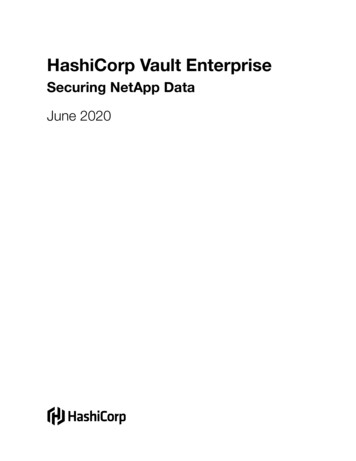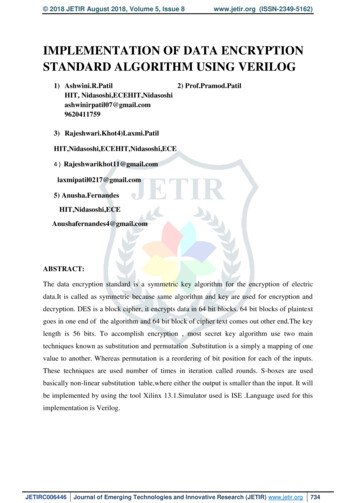
Transcription
2018 JETIR August 2018, Volume 5, Issue 8www.jetir.org (ISSN-2349-5162)IMPLEMENTATION OF DATA ENCRYPTIONSTANDARD ALGORITHM USING VERILOG1) Ashwini.R.Patil2) Prof.Pramod.PatilHIT, m96204117593) idasoshi,ECE4 ) 5) gmail.comABSTRACT:The data encryption standard is a symmetric key algorithm for the encryption of electricdata.It is called as symmetric because same algorithm and key are used for encryption anddecryption. DES is a block cipher, it encrypts data in 64 bit blocks. 64 bit blocks of plaintextgoes in one end of the algorithm and 64 bit block of cipher text comes out other end.The keylength is 56 bits. To accomplish encryption , most secret key algorithm use two maintechniques known as substitution and permutation .Substitution is a simply a mapping of onevalue to another. Whereas permutation is a reordering of bit position for each of the inputs.These techniques are used number of times in iteration called rounds. S-boxes are usedbasically non-linear substitution table,where either the output is smaller than the input. It willbe implemented by using the tool Xilinx 13.1.Simulator used is ISE .Language used for thisimplementation is Verilog.JETIRC006446Journal of Emerging Technologies and Innovative Research (JETIR) www.jetir.org734
2018 JETIR August 2018, Volume 5, Issue 8www.jetir.org (ISSN-2349-5162)INTRODUCTION:There are mainly 2 types of cryptography are there–symmetricor secret key cryptographyand asymmetric or public key cryptography. Symmetrickeycryptography is the oldest typewhereas asymmetric cryptography is only beingused publicly since the late 1970’s. Secretkey cryptography goes back to at least Egyptian times and is of concern here. It involves theuse of only one key which is used for both encryption and decryption (hence the use of theterm symmetric). Figure 2.1 depicts this symmentric key cryptography.Figure 2.1: Secret key encryption.In encryption process we have mainly 2 opertions, Substitution and Permutation. Substitutionis simply a mapping of one value toanother value whereas permutation is a reordering of thebit positions for each of the inputs.These techniques are used a number of times in iterationscalled rounds. More rounds means more secure algorithm. A non-linearity is alsointroducedinto theencryption so that decryption will be computationally infeasible without the secretkey. This is achieved with the use of S-boxes which are basicallynon-linear substitutiontables where either the output is smaller than the input or viceversa.The main problem arised in secret key is key distribution.For this purpose sender and receivermust know the key. Thiswould have to be communicated over some secure channel which,unfortunately, is notthat easy to achieve. As will be seen later, public key cryptographyprovides a solutionto this.BRIEF HISTORY OF DES:Up till we have a standard algorithm for encryption as Data Encryption Standard Algorithm.But now a days it is replaced with a new standard known as the Advanced EncryptionStandard (AES). DES is a 64 bit block cipher which means that it encrypts data 64bits at atime. Stream cipher encrypts only one bit at a time.DES was the result of a research projectset up by International Business Machines(IBM) corporation in the late 1960’s which resultedin a cipher known as LUCIFER. Inthe early 1970’s it was decided to commercialiseLUCIFER and a number of significantchanges were introduced. IBM was not the only oneinvolved in these changes asthey sought technical advice from the National Security AgencyJETIRC006446Journal of Emerging Technologies and Innovative Research (JETIR) www.jetir.org735
2018 JETIR August 2018, Volume 5, Issue 8www.jetir.org (ISSN-2349-5162)(NSA) (other outsideconsultants were involved but it is likely that the NSA were the majorcontributorsfrom a technical point of view). The altered version of LUCIFER was putforward asa proposal for the new national encryption standard requested by the NationalBureauof Standards (NBS). It was finally adopted in 1977 as the Data Encryption StandardDES (FIPS PUB 46).Some of the changes made to LUCIFER have been the subject of much controversyeven tothe present day. The most notable of these was the key size. LUCIFER useda key size of 128bits however this was reduced to 56 bits for DES. Even though DESactually accepts a 64 bitkey as input, the remaining eight bits are used for paritychecking and have no effect onDES’s security. Outsiders were convinced that the 56bit key was an easy target for a bruteforce attack4 due to its extremely small size. Theneed for the parity checking scheme was alsoquestioned without satisfying answers.Another controversialissue wasthat the S-boxesused were designed underclassifiedconditions and no reasons for their particular design were ever given. This ledpeople to assume that the NSA had introduced a “trapdoor” through which they coulddecryptany data encrypted by DES even without knowledge of the key. One startlingdiscoverywas that the S-boxes appeared to be secure against an attack known asDifferentialCryptanalysis which was only publicly discovered by Biham and Shamir in1990.This suggests that the NSA were aware of this attack in 1977; 13 years earlier! Infactthe DES designers claimed that the reason they never made the design specificationsforthe S-boxes available was that they knew about a number of attacks that weren’t publicknowledge at the time and they didn’t want them leaking - this is quite a plausibleclaim asdifferential cryptanalysis has shown. However, despite all this controversy, in1994 NISTreaffirmed DES for government use for a further five years for use in areasother than“classified”.DES of course isn’t the only symmetric cipher. There are many others, each withvaryinglevels of complexity. Such ciphers include: IDEA, RC4, RC5, RC6 and thenewAdvanced Encryption Standard (AES). AES is an important algorithm and wasoriginallymeant to replace DES (and its more secure variant triple DES) as thestandardalgorithm for non-classifiedmaterial. However as of 2003, AES with key sizes of192and 256 bits has been found to be secure enough to protect information up to top se-cret.Since its creation, AES had underdone intense scrutiny as one would expect foran algorithmJETIRC006446Journal of Emerging Technologies and Innovative Research (JETIR) www.jetir.org736
2018 JETIR August 2018, Volume 5, Issue 8www.jetir.org (ISSN-2349-5162)that is to be used as the standard. To date it has withstood all attacks butthe search is still onand it remains to be seen whether or not this will last. We willlook at AES later in the course.INNER WORKINGS OF DES:DES (and most of the other major symmetric ciphers) is based on a cipher known as theFeistel block cipher. This was a block cipher developed by the IBM cryptographyresearcherHorst Feistel in the early 70’s. It consists of a number of rounds whereeach round containsbit-shuffling, non-linear substitutions (S-boxes) and exclusive ORoperations. Most symmetricencryption schemes today are based on this structure(known as a feistel network).As with most encryption schemes, DES expects two inputs - the plaintext to be encryptedandthe secret key. The manner in which the plaintext is accepted, and the keyarrangement usedfor encryption and decryption, both determine the type of cipher itis. DES is therefore asymmetric, 64 bit block cipher as it uses the same key for bothencryption and decryption andonly operates on 64 bit blocks of data at a time5 (be theyplaintext or ciphertext). The key sizeused is 56 bits, however a 64 bit (or eight-byte)key is actually input. The least significant bitof each byte is either used for parity (oddfor DES) or set arbitrarily and does not increase thesecurity in any way. All blocks arenumbered from left to right which makes the eight bit ofeach byte the parity bit.Once a plain-text message is received to be encrypted, it is arranged into 64 bitblocksrequired for input. If the number of bits in the message is not evenly divisible by 64,then the last block will be padded. Multiple permutations and substitutions areincorporatedthroughout in order to increase the difficulty of performing a cryptanalysis onthecipher. However, it is generally accepted that the initial and final permutations offerlittle orno contribution to the security of DES and in fact some software implementations omit them(although strictly speaking these are not DES as they do not adhere to the standard).OVERALL STRUCTURE:Figure 2.2 shows the sequence of events that occur during an encryption operation. DESperforms an initial permutation on the entire 64 bit block of data. It is then splitinto 2, 32 bitsub-blocks, Li and Ri which are then passed into what is known as around (see figure 2.3), ofwhich there are 16 (the subscript i in Li and Ri indicatesthe current round). Each of theJETIRC006446Journal of Emerging Technologies and Innovative Research (JETIR) www.jetir.org737
2018 JETIR August 2018, Volume 5, Issue 8www.jetir.org (ISSN-2349-5162)rounds are identical and the effects of increasing theirnumber is twofold - the algorithmssecurity is increased and its temporal efficiencydecreased. Clearly these are two conflictingoutcomes and a compromise must bemade. For DES the number chosen was 16, probably toguarantee the elimination ofany correlation between the ciphertext and either the plaintext orkey6. At the end of the16th round, the 32 bit Li and Ri output quantities are swapped tocreate what is knownas the pre-output. This [R16, L16] concatenation is permuted using afunction whichis the exact inverse of the initial permutation. The output of this finalpermutation isthe 64 bit ciphertext.Figure 2.2: Flow Diagram of DES algorithm for encrypting data.So in total the processing of the plaintext proceeds in three phases as can be seen from the lefthand side of figure 2.2:1. Initial permutation (IP - defined in table 2.1) rearranging the bits to form the“permutedinput”.JETIRC006446Journal of Emerging Technologies and Innovative Research (JETIR) www.jetir.org738
2018 JETIR August 2018, Volume 5, Issue 8www.jetir.org (ISSN-2349-5162)2. Followed by 16 iterations of the same function (substitution and permutation).The outputof the last iteration consists of 64 bits which is a function of theplaintext and key. The leftand right halves are swapped to produce the preoutput.3. Finally, the preoutput is passed through a permutation (IP 1 - defined in table2.1) which issimply the inverse of the initial permutation (IP). The output ofIP 1 is the 64-bit 719212310121416911131524681357Initial 125297158132367101114151819222326273031Expansion Permutation 3259131721252912831341710925Journal of Emerging Technologies and Innovative Research (JETIR) www.jetir.org739
2018 JETIR August 2018, Volume 5, Issue 8www.jetir.org (ISSN-2349-5162)Permutation Function 5552314542213532112522011511910501894917Inverse Initial permutation64636261605958573231302928272625Table 2.1: Permutation Tables Used in DESAs figure 2.2 shows, the inputs to each round consist of the Li,Ri pair and a 48bitsubkeywhich is a shifted and contracted version of the original 56 bit key. The use of thekey can be seen in the right hand portion of figure 2.2: Initially the key is passed through a permutation function (PC1 - defined in table 2.2) For each of the 16 iterations, a subkey (Ki) is produced by a combination of aleftcircular shift and a permutation (PC2 - defined in table 2.2) which is the same foreach iteration. However, the resulting subkey is different for each iteration because ofrepeated 44526041505934754615513212937455361Input 7361522294Journal of Emerging Technologies and Innovative Research (JETIR) www.jetir.org740
2018 JETIR August 2018, Volume 5, Issue 8www.jetir.org (ISSN-2349-5162)Permuted berof 25036Permuted Choice-2 1122222212222221Schedule Of Left ShiftDETAILS OF INDIVISUAL ROUNDS:Details of an individual round can be seen in figure 2.3. The main operations on thedata areencompassed into what is referred to as the cipher function and is labeled F. This functionaccepts two different length inputs of 32 bits and 48 bits and outputs a single 32 bit number.Both the data and key are operated on in parallel, however the operations are quite different.The 56 bit key is split into two 28 bit halves Ci and Di (C and D being chosen so as not to beconfused with L and R). The value of the key used in any round is simply a left cyclic shiftand a permuted contraction of that used in the previous round. Mathematically, this can bewritten as Ci Lcsi(Ci-1)Di Lcsi(Di-1)Ki PC2(Ci,Di)whereLcsi is the left cyclic shift for round i, Ci and Di are the outputs after the shifts,PC2(.)is a function which permutes and compresses a 56 bit number into a 48 bit number and Ki isthe actual key used in round i. The number of shifts is either one or two and is determined bythe round number i. For i {1, 2, 9, 16} the number of shifts is one and for every other roundit is two (table 2.2).JETIRC006446Journal of Emerging Technologies and Innovative Research (JETIR) www.jetir.org741
2018 JETIR August 2018, Volume 5, Issue 8www.jetir.org (ISSN-2349-5162)Fig 2.3: Details OfIndivisual RoundsThe common formulas used to describe the relationships between the input to oneround and its output (or the input to the next round) are:Li Ri-1,Ri Li-1 F(Ri-1,Ki)where L and R have their usual meaning and F(.) is the cipher function. This functionF is the main part of every round and consists of four separate stages (see figure 2.4):1. The E-box expansion permutation - here the 32-bit input data from Ri 1 is expandedand permuted to give the 48 bits necessary for combination with the 48 bit key(defined in table 2.1). The E-box expansion permutation delivers a larger output bysplitting its input into 8, 4-bit blocks and copying every first and fourth bit in eachblock into the output in a defined manner. The security offered by this operationcomes from one bit affecting two substitutions in the S-boxes This causes thedependency of the output bits on the input bits to spread faster,and is known as theavalanche affect.2. The bit by bit addition modulo 2 (or exclusive OR) of the E-box output and 48bitsubkey Ki.JETIRC006446Journal of Emerging Technologies and Innovative Research (JETIR) www.jetir.org742
2018 JETIR August 2018, Volume 5, Issue 8www.jetir.org (ISSN-2349-5162)3. The S-box substitution - this is a highly important substitution which accepts a48-bitinput and outputs a 32-bit number (defined in table 2.3). The S-boxes arethe only nonlinear operation in DES and are therefore the most important partof its security. Theywere very carefully designed although the conditions theywere designed under hasbeen under intense scrutiny since DES was released.The reason was because IBM hadalready designed a set of S-boxes which werecompletely changed by the NSA with noexplanation why.The input to the S-boxes is 48 bits long arranged into 8, 6 bit blocks (b1, b2, . . . , b6). Thereare 8 S-boxes (S1, S2, . . . , S8) each of which accepts one of the 6 bit blocks. The output ofeach S-box is a four bit number. Each of the S-boxes can be thought of as a 4 16 matrix.Each cell of the matrix is identified by a coordinate pair (i, j), where 0 i 3 and 0 j 15.The value of i is taken as the decimal representation of the first and last bits of the input toeach S-box, i.e. Dec(b1b6) i and the value of j is take from the decimal representation ofthe inner four bits that remain, i.e. Dec(b2b3b4b5) j. Each cell within the S-box matricescontains a 4-bit number which is output once that particular cell is selected by the input.4. The P-box permutation - This simply permutes the output of the S-box withoutchanging the size of the data (defined in table 2.1). It is simply a permutation andnothing else. It has a one to one mapping of its input to its output giving a 32 bitoutput from a 32 bit input.OTHER POINTS OF VIEW:Having looked at DES in some detail a brief look at some other points is in order.Theseinclude decryption, modes of operation, security etc.MODES OF OPERATION:The DES algorithm is a basic building block for providing data security. To applyDES in avariety of applications, five modes of operation have been defined which cover virtually allvariation of use of the algorithm and these are shown in table 2.4.S1JETIRC006446Journal of Emerging Technologies and Innovative Research (JETIR) www.jetir.org743
2018 JETIR August 2018, Volume 5, Issue 41316S813172www.jetir.org 050153014351295672811Fig 2.3: S-Box TableJETIRC006446Journal of Emerging Technologies and Innovative Research (JETIR) www.jetir.org744
2018 JETIR August 2018, Volume 5, Issue 8www.jetir.org (ISSN-2349-5162)Fig 2.4: The Complex F Function Of the DES algorithmModes Of Operations:ModeElectronic CodeDescriptionEach block of 64 plaintextTypical ApplicationSecure Transmission ofBook(ECB)bits is encodedsingle values.independently using thesame keyCipher BlockTheinputtothe AuthenticationChaining(CBC)encryption algorithm is theXOR of the next 64 bits ofplaintext and the preceding64 bits of cipher text.Cipher Feedback(CFB)Output feedback(OFB)JETIRC006446Input is processed J bits atGeneral purpose streama time.oriented transmission.Similar to CFB except thatStream orientedthe input to the encryptiontransmission over noisyJournal of Emerging Technologies and Innovative Research (JETIR) www.jetir.org745
2018 JETIR August 2018, Volume 5, Issue 8www.jetir.org (ISSN-2349-5162)algorithm is the precedingchannel.DES output.Counter(CTR)Each block of plain text isUseful for high speedXORed with an encryptedrequirements.counter.The counter isincremented for eachsubsequent block.Table 2.4: DES Modes Of OperationsDES DECRYPTION:The decryption process with DES is essentially the same as the encryption process and is asfollows:Use the ciphertext as the input to the DES algorithm but use the keysKi in reverse order. Thatis, use K16 on the first iteration, K15 on the second until K1which is used on the 16th andlast iteration.CONCLUSION:In this paper, we have discussed the High Level Language implementation of DES. Ourdesign is efficient in comparison to other software implementations and it utilizes lesshardware resource on FPGA and takes less development time.REFERENCES:1) Journal of Computer Science of Newports Institute of Communications andEconomics Volume 5, Issue-2014, ISSN: 2226-3683.2) Cunsheng Ding Department of Computer Science Hong Kong University of Scienceand Technology Clearwater Bay, Kowloon, Hong Kong, CHINA.JETIRC006446Journal of Emerging Technologies and Innovative Research (JETIR) www.jetir.org746
The data encryption standard is a symmetric key algorithm for the encryption of electric data.It is called as symmetric because same algorithm and key are used for encryption and decryption. DES is a block cipher, it encrypts data in 64 bit blocks. 64 bit blocks of plaintext


